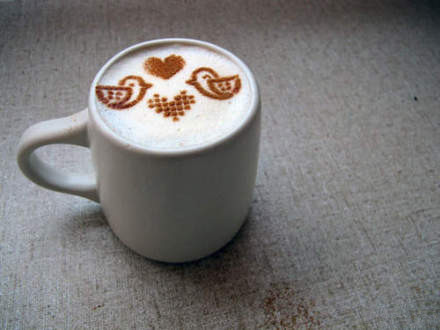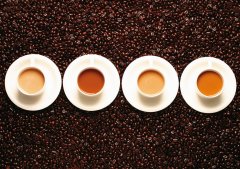History of coffee flower drawing
From 1980 to 1990, the art of flower drawing developed in Seattle, USA. In particular, David Shaumel popularized the art of coffee flower drawing. In 1986, Shaumel affirmed the development of microbubbles ("velvet foam" or "milk texture") to Jack Kelly, who works at the Uptown espresso Cafe, and since then the heart-shaped pattern has become a signature product at the "Espresso Vivace" Cafe in 1989. Shaumel created the rose flower pattern in 1992 after seeing a photo of Cafe Mateki, an Italian cafe. Shaumel then popularized the art of latte drawing in his training class. Meanwhile, Italy's Luigi Lupi got in touch with Shaumel online and shared videos of each other making lattes and cappuccino decorations.

The ingredient of coffee flower
Latte pull is actually a mixture of two sticky liquids: espresso and milk microbubbles. Espresso is a sticky liquid coffee with coffee fat (a layer of foam floating on espresso); milk microbubbles refer to beating milk into foam with a milk foam machine. The milk itself requires full-fat liquid milk, while coffee is thickly liquid. Neither coffee nor milk is in a steady state. Coffee fat is separated from espresso, while milk bubbles are obtained from liquid milk. Coffee fat and milk bubbles disappear in just a few minutes, so coffee flowers are kept for a short time.
The technology of coffee flower drawing
Coffee cups first need to make espresso and milk microbubbles with coffee fat, and then synthesize them into latte flowers.
Espresso must have enough fat on the surface before adding milk. When the white foam is poured into the reddish brown coffee, the sharp color contrast presents a creative pattern. After the milk is poured, the foam separates from the liquid and rises to the surface. If the amount of milk and espresso is "just right", the milk can moves left and right as it is dumped, and the foam rises and forms a pattern on the surface. Sometimes, a pattern can be drawn on the foam with a flower needle or stick, but not necessarily in the process of pouring.
There is a different view in the coffee community that baristas are too concerned about the styling of lattes. The view is that we pay too much attention to the external image of coffee rather than fancy coffee itself, such as taste and other factors. This is even more important for novice baristas.
The types of coffee flowers
At present, two kinds of flower drawing are widely used: "free dumping" (the pattern is formed when the milk foam is dumped) and "carving" (painting on the milk foam after the milk is poured with a coffee needle). Free dumping is more widely used in American cafes, which requires more preparation time when making coffee.
Dumping
The most common patterns of toppling flowers are heart-shaped, rose-shaped and fern leaf-shaped. The heart shape is easier to make and is often used to make macchiato, while the rose shape is more complex and is often used to make lattes. More complex patterns are also possible, some of which need to be dumped several times.
Carved flowers
Carved patterns can range from simple geometry to complex paintings, such as three-dimensional shapes with shadows: animals, flowers, etc., and some patterns need to be fixed with a coffee blender. The life of the carved coffee is shorter than that of the dumping technique, because the foam breaks down faster.
If you want to learn to make beautiful coffee flowers, you can read "Fashion Beverage: fancy Coffee pattern production" or follow some videos of coffee patterns.
Important Notice :
前街咖啡 FrontStreet Coffee has moved to new addredd:
FrontStreet Coffee Address: 315,Donghua East Road,GuangZhou
Tel:020 38364473
- Prev

The development history of coffee in China
In China, people like drinking coffee more and more. The ensuing "coffee culture" is full of every moment of life.
- Next

The origin of the history of lattes in coffee
The first person to add milk to the coffee was Kochsky of Vienna, who also opened the first coffee shop in Vienna.
Related
- How did the Salvadoran coffee industry develop in Central America?
- What exactly does the golden cup extraction of coffee mean?
- The Origin of Coffee flower
- [2023 Starbucks World Earth Day] there are more meaningful things besides free Starbucks coffee!
- What kind of coffee is there in Spain? 9 Flavors of Spanish Coffee
- Aromatic African coffee| Kenya's coffee culture and historical production area
- Liberica Coffee Bean knowledge: the characteristics of Liberian Coffee beans of the three original species of Coffee beans
- The origin and formula of Spanish latte introduces the taste characteristics of Bombon coffee in Valencia, Spain.
- How to adjust the solution of over-extracted coffee
- What is the tasting period of coffee beans? What is the period of coffee and beans? How should coffee wake up and raise beans?

